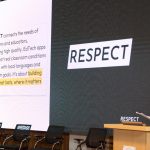February 22, 2021
Natalija Budinski explores how to motivate more girls to develop and maintain an interest in STEM

It is well known that STEM stands for Science, Technology, Engineering and Mathematics and represents a combination of those disciplines. That is why STEM is considered as an interdisciplinary approach. It means that those subjects are not separated but integrated and oriented to a real-world application of the underlying skills. Interest in this form of education increased as the world started to enter the 4.0 technological revolution and rapidly changed through the vast use of technology. There are numerous benefits of STEM in developing the skills students need for their future life. Interdisciplinary activities encourage experimentation, team work or knowledge application, but also provide a meaningful use of technology and adoption of new ways of divergent thinking and problem solving. It is very important to say that STEM supports creativity and critical thinking which form two key competencies for the future.
STEM as an interdisciplinary concept is important because the jobs of today and future jobs are, or will be based on such concepts. STEM careers are quite various and diverse, from civil engineering to work in a laboratory or bank. Referred to as jobs of the future, the corpus of STEM jobs is growing and there are low rates of unemployment and an increasing demand for STEM professionals.
But somehow, girls and women are not in an equal position in the jobs race. That situation affects the general economy and development. Many girls give up on studying STEM too early, even though that at a young age they could gain transferable skills which are useful for their future life. By developing confidence and creativity through a STEM education, girls could be equipped with the knowledge and confidence to make changes in their communities. Many communities around the world face problems with energy, pollution, food production, clean water, health issues and girls could be part of the solution.
One approach to increase a girl’s interest in STEM disciplines could be to show them that women can be successful in many jobs that are traditionally considered as jobs exclusive for men. It is important for girls to have adequate role models, in order to start thinking that a STEM career is a possibility for them. They must know that they are not alone and that many women and girls fulfilled their dreams about being scientists, technologist, engineers or mathematicians. There are many examples of women throughout history that have shown exquisite passion, knowledge and strength in discovering science and mathematics. One of the most impressive examples is Maria Curie, who received two Nobel prizes or Hedy Lamarr, who was a Hollywood actress but also an inventor in the field of telecommunication. Even though those examples from the past are remarkable and significant, girls need more modern and contemporary role models. What is more, they need someone close and comparable, and a good suggestion could be a role model from their community or someone that went to their school who then had a successful career in a STEM related field.
Unfortunately, gender is not the only reason why girls give up STEM. We found out that girls that come from vulnerable groups have even less chance to pursue such a career. That is why we started a project called Bilingual STEM female scientists. The project is supported by the Serbian Ministry of Education. The goal of the project is to empower girls to choose their future careers in a STEM field in order to secure a better future for them. In the project activities we promote an inter-disciplinary education to girls in bilingual and minority communities, where girls are reluctant to study these subjects. We invited about ten female scientists from different minority communities in Serbia, such as Ruthenian, Slovakian, Hungarian and Bosnian, all of them had an opportunity to educate in their mother tongue, which they speak besides the Serbian language. During the project female scientists promoted their research and articulated the benefits of bilingualism in STEM education. The project aims to break the stereotypes about women in STEM, but also about minorities and bilingualism.










0 Comments